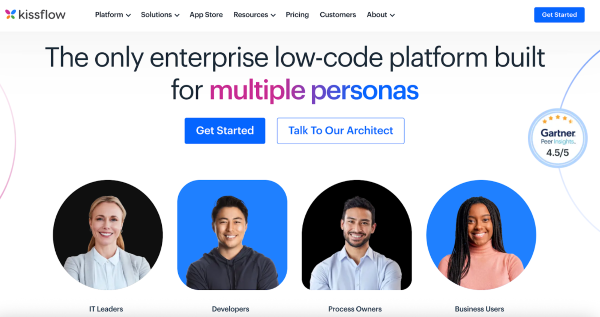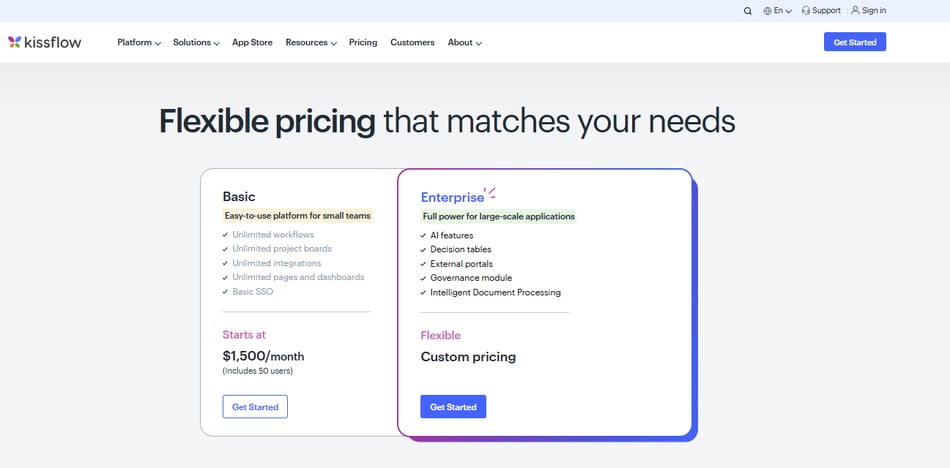If you’ve explored workflow automation for businesses, you’ve likely heard of Kissflow and Microsoft Power Automate. While both tools offer useful capabilities, they come with trade-offs in terms of scalability, ease of use, and hidden costs.
In this article, we delve into Kissflow vs Power Automate and explain why FlowForma is a more intelligent and scalable choice for businesses ready to automate without complexity.
What is Kissflow?
Kissflow is a no-code automation tool designed for business teams that want to digitize basic processes, such as leave requests or onboarding, without relying on IT.
The platform integrates with tools like Google Workspace, Slack, and Zapier, making integration straightforward for cloud-native teams.
 Kissflow markets itself as a platform for multiple business personas
Kissflow markets itself as a platform for multiple business personas
Here are five use cases for Kissflow:
- Leave request management: Automates the entire leave application and approval process with custom workflows.
- Purchase approvals: Streamlines procurement by routing purchase requests to designated approvers.
- Employee onboarding: Simplifies HR onboarding with checklists, task assignments, and document tracking.
- Expense reimbursements: Enables staff to submit expense claims and receive approvals without email follow-ups.
- IT service requests: Provides a structured workflow for internal tech support and ticket resolution.
While effective for lightweight tasks, Kissflow doesn’t scale well for complex, enterprise-grade workflows. It’s best suited for small to mid-sized teams with basic automation needs, rather than for organizations requiring advanced logic or regulatory controls, such as those in finance, healthcare, or government.
Besides, it lacks native integration with Microsoft 365 and SharePoint, which creates friction for Microsoft-centric organizations and propels them to seek Kissflow alternatives.
What is Power Automate?
Microsoft Power Automate helps teams automate workflows across Microsoft 365 tools like SharePoint, Teams, Outlook, and Excel. It supports common tasks such as onboarding, approvals, data syncing, and notifications through prebuilt templates and connectors.
 Power Automate’s homepage
Power Automate’s homepage
Here are a few of Power Automate’s typical use cases:
Use cases include:
- Onboarding automation: Account setup, equipment requests, and policy tasks.
- Multi-level approvals: Leave, expenses, or documents with dynamic routing.
- Data sync: Updates across Excel, SharePoint, and third-party platforms.
- Notifications: Alerts via Teams or email on data changes.
- Customer support routing: Form or email triggers sent to the right teams.
 Power Automate’s main use cases
Power Automate’s main use cases
While it claims to be user-friendly, building advanced workflows often requires knowledge of Power Fx and tools like Power Apps and Dataverse. This adds complexity, especially for non-technical teams.
Licensing can also be confusing, with additional costs for premium connectors and AI Builder features, making Power Automate better suited for Microsoft-centric enterprises with dedicated IT support.
Kissflow vs Power Automate: Key Features
If you're here, you're likely evaluating Kissflow and Power Automate for your business process automation needs. The table below compares these two platforms across several key criteria.
We’ve also included FlowForma to offer an additional perspective, especially for teams looking for a no-code solution with deeper Microsoft 365 integration and built-in compliance features.
|
Feature |
Kissflow |
Power Automate |
FlowForma |
|
Ease of Use |
No-code, user-friendly |
Low-code, but with a learning curve |
True no-code, built for mid- to large-sized enterprises |
|
Microsoft 365 Integration |
Basic integration |
Deep integration |
Native integration with SharePoint, Teams, and Power BI |
|
Document Generation |
Basic |
Requires Power Automate flows |
Built-in, dynamic document generation |
|
AI Capabilities |
Limited |
AI Builder (add-on, usage-capped) |
AI Copilot + Agentic AI (in-built) |
|
Compliance Tools |
Limited |
Add-on dependent |
Built-in audit trails |
|
Mobile Access |
Available |
App-based experience |
Mobile-ready |
Kissflow vs Power Automate: Pricing and Licensing Options
For many businesses, choosing the right platform often comes down to more than just features. Pricing transparency and predictability play a critical role, especially as businesses scale. Here’s how each platform compares when it comes to licensing and cost structure.
Kissflow Pricing
Kissflow offers tiered pricing per user, starting at $1,500 per month for the Basic plan. As your team grows or you require advanced functionality, costs can escalate significantly.
While its pricing is more predictable than usage-based models, it may still fall short for businesses needing multiple departmental workflows and enterprise features under a unified cost structure.

Kissflow’s pricing structure
Power Automate Pricing
Microsoft Power Automate offers both bundled and standalone licensing options. It is included in Microsoft 365 Enterprise plans (E3 and E5) and is also available as a standalone product with a 30-day free trial.
 Microsoft’s leading Enterprise bundles
Microsoft’s leading Enterprise bundles
Standalone plans start at $15 per user/month for the Premium plan, which includes cloud flows, attended desktop flows, and access to standard, premium, and custom connectors.
 Power Automate’s standalone pricing structure
Power Automate’s standalone pricing structure
While the base pricing may appear cost-effective, the need for premium features and connectors can lead to higher expenses as automation needs grow.
For instance, premium connectors and AI Builder capabilities are not included in the base plan and must be purchased separately. AI Builder add-ons are priced at $500 per unit/month.
These additional costs can make budgeting challenging, especially for organizations planning to scale automation across multiple departments.
Also read: Check out our in-depth guide on Power Automate pricing to learn more.
How FlowForma pricing compares to Kissflow and Power Automate
FlowForma provides predictable, all-in-one pricing with no extra costs for usage or core features—ideal for scaling automation.
Kissflow starts cheap but adds up quickly. Power Automate appears affordable at first, but often incurs escalating, unpredictable costs.
 FlowForma’s process-based pricing packages
FlowForma’s process-based pricing packages
Here's a focused pricing and cost comparison table for FlowForma, Kissflow, and Power Automate:
|
Pricing Factor |
FlowForma |
Kissflow |
Power Automate |
|
Base Pricing Model |
Flat, tiered, process-based pricing |
Per-user, per-feature tiered pricing |
Per-user or per-flow pricing |
|
Workflow Execution Costs |
Unlimited workflows included |
Limited by tier |
Usage-based (extra cost per run beyond limits) |
|
Add-On Costs |
None – all core features included |
Extra for integrations or advanced features |
Extra for premium connectors, AI Builder, and custom APIs |
|
Cost Predictability |
High. |
Medium. Can escalate with usage or add-ons |
Low. Costs scale with volume and tool dependencies |
|
Scalability of Pricing |
Scales with processes, not usage volume |
Costs rise quickly with users/features |
Becomes costly with high automation volume |
Kissflow vs Power Automate: What Do Customer Reviews Say?
Both Kissflow and Power Automate have multiple reviews on platforms like G2 and TrustRadius.
While Kissflow is praised for its simplicity, users flag its lack of scalability and enterprise functionality. Users appreciate the quick setup, but often outgrow its capabilities rather quickly.
Take a look at this G2 review from a user in the education sector. They compliment Kissflow for its intuitiveness and capability, but immediately indicate that the tool has some missing features.
 A G2 review for Kissflow focusing on its limited features
A G2 review for Kissflow focusing on its limited features
Another G2 review provides even more details about the tool's overall functionality. This reviewer is more critical of Kissflow’s pricing structure, which may get complicated as your business scales.
 Comprehensive G2 review focusing on the pricing complexities of Kissflow
Comprehensive G2 review focusing on the pricing complexities of Kissflow
Here are a few pros and cons of Kissflow extracted directly from multiple G2 reviews.
Kissflow Pros
- Ease of use with no-code simplicity
- Allows basic customizations
- Flexibility to work on multiple processes
- Integration with numerous third-party tools
Kissflow Cons
- Limited features for complex automation
- Limitations around access control
- No compliance/audit trail features
When it comes to Power Automate, users frequently cite a steep learning curve, technical dependency, and surprise costs, such as premium connectors and execution limits.
This review describes Power Automate’s limitations:
 A G2 review for Power Automate focusing on its difficult interface
A G2 review for Power Automate focusing on its difficult interface
Here are a few pros and cons of Power Automate extracted directly from multiple G2 reviews.
Power Automate Pros
- Native integration with Microsoft solutions
- AI Builder available
- Ability to handle multiple data sources together
Power Automate Cons
- Complex interface with a steep learning curve
- May require PowerFx coding for more complex automations
- Debugging can be time-consuming
Where does FlowForma stand?
FlowForma, by contrast, holds a 4.4/5 rating on G2. Reviewers highlight its excellent support, actual no-code usability, and time-saving AI features. Business users appreciate that they can take ownership of workflows without relying on IT.
 G2 review indicating FlowForma’s strengths
G2 review indicating FlowForma’s strengths
Here are a few pros and cons of FlowForma extracted directly from G2:
FlowForma Pros
- Drag-and-drop workflow builder
- Native SharePoint integration
- Flexibility for multiple use cases
- Incredible customer support
- AI Copilot and Agentic AI capabilities
FlowForma Cons
- Dependence on SharePoint infrastructure
Kissflow vs Power Automate vs FlowForma: Which is Best for Your Business?
If you’re a small team with basic needs, Kissflow may work. If you’re already deep in Microsoft 365 and have IT support and a significant budget, Power Automate might fit. But for organizations that need scalable, AI-powered, no-code automation without relying on developers, FlowForma stands out.
It combines forms, workflows, AI, and compliance tools in one seamless platform—no hidden fees or connector costs. Built for business users, FlowForma empowers teams to automate processes fast, without IT bottlenecks.
Key advantages of FlowForma over Kissflow and Power Automate
When comparing Kissflow vs Power Automate, FlowForma stands out as the superior no-code platform that is trusted by leading global brands across diverse industries, as showcased in this video.
Here’s what it brings to the table:
- Actual no-code design: FlowForma enables business users to automate processes without relying on IT or writing a single line of code. Kissflow supports basic flows but lacks enterprise features. Power Automate often requires knowledge of Power Fx, APIs, and external connectors.
- Unified platform for form and workflow automation: Unlike Power Automate, which requires stitching together Power Apps, AI Builder, and Power BI, FlowForma delivers a unified platform for form automation, workflow automation, document generation, analytics, and compliance.
 Workflow setup using FlowForma
Workflow setup using FlowForma
- AI Copilot for enhanced workflows: FlowForma’s AI Copilot enables users to create workflow rules, define conditions, and automate logic using simple language prompts. This reduces the need for technical input, allowing teams to build sophisticated workflows with greater confidence and speed.
- Faster deployment: With FlowForma’s intuitive drag-and-drop builder, AI Copilot, and ready-to-use templates, you can go live in days, not weeks. No development backlog, no learning curve.
- AI-powered compliance automation: FlowForma’s compliance engine leverages AI to ensure processes align with regulatory frameworks, including the General Data Protection Regulation (GDPR), International Standards Organization (ISO), Digital Operational Resilience Act (DORA), and Health Insurance Portability and Accountability Act (HIPAA), thereby reducing risk and audit fatigue.
 FlowForma’s compliance module: Benefits
FlowForma’s compliance module: Benefits
- Transparent, predictable pricing: FlowForma offers tiered pricing based on the number of processes, not users or flow runs. The pricing starts from €2,067 per month for automating up to 3 processes.

FlowForma’s pricing structure
- AI-driven insights: FlowForma harnesses AI-driven insights to continuously analyze your workflows, identify bottlenecks, and suggest improvements. This intelligent analytics layer ensures your processes evolve dynamically alongside your business needs, enabling data-backed decision-making and operational excellence.

A look at the unique benefits of FlowForma’s built-in analytics and reporting
- Agentic AI: FlowForma’s Agentic AI is a smart, lightweight AI agent that integrates seamlessly anywhere within your workflows to deliver instant, context-aware responses based on your custom prompts. Unlike bulky AI platforms or generic chatbots, this modular agent acts like a domain expert embedded at every step—understanding your specific role, data, and process context to answer questions, automate decisions, and eliminate repetitive slowdowns.
- Document generation for real-time reporting: Automatically generate and share documents, summaries, and reports as part of any workflow, without the need for third-party tools.
FlowForma in the real world: How Coinford employees saved up to 20% of their time with FlowForma
One of FlowForma’s standout success stories comes from Coinford, a respected construction company operating across 30 sites in southeast England. Coinford was facing typical industry challenges like disconnected site and back-office workflows, cumbersome paperwork, and compliance pressures.

Coinford’s success story
It leveraged FlowForma to digitize 25 key processes. Using tablets and 5G connectivity, site teams can now capture and log data instantly, replacing tedious paper trails and endless emails with streamlined, auditable workflows for inspections, defect management, and compliance with regulations like the Building Safety Act 2022.
Within just 18 months, Coinford reported saving up to two hours daily per site manager, cutting administrative time in half, and achieving better visibility across departments—all of which drove operational efficiency and cost savings.
Their story exemplifies how FlowForma empowers organizations to digitize workflows faster, reduce IT dependency, and boost productivity across complex, multi-site operations.
Experience the same success as Coinford and numerous others. Digitize workflows faster, at a lower cost, and without IT dependency?
Get a 7-day free trial today.
 By
By 




